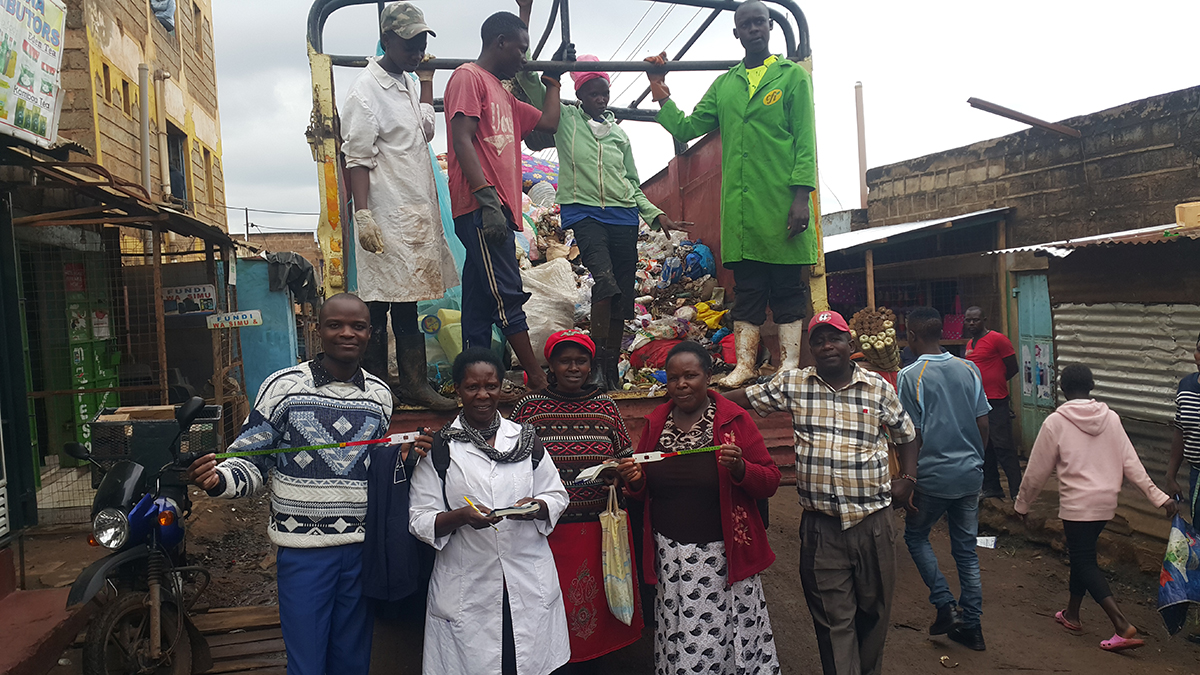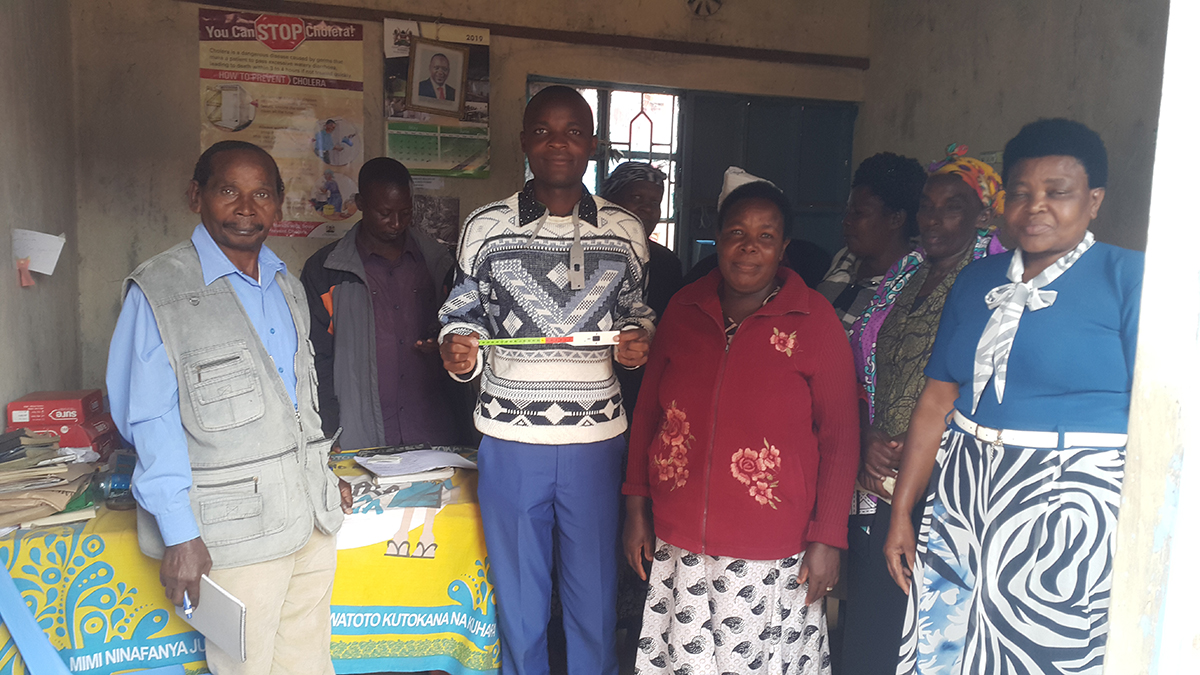
Meeting with the community Health volunteers to discuss malnutrition among other community health problems.
Photo credit: Stephen Odiwuor
Problem Statement
Malnutrition is one of the major public health issues of importance among developing countries. According to Faye O., et al (2012), malnutrition and childhood morbidity contribute a lot to child mortality and disability adjusted life years. The Global Nutrition Report, (2016), also cited that out of 667 million children under age five worldwide, 159 million under age five are too short for their age (stunted), 50 million do not weigh enough for their height(wasted), and 41 million are overweight. In Kenya, one-third of children under-five are stunted, one in six children is underweight or too thin for their age, more than seven million children who are under five years die each year from treatable and preventable conditions. Pneumonia, malaria, and diarrhea remain the leading causes of child mortality and under nutrition contributes to more than one third of all deaths (maternal and child health Kenya, 2012).
In order to meet the global nutrition targets of cutting the number of stunted children by 40 percent by 2025, reducing and maintaining child wasting by five percent by 2025, and no increase in childhood obesity by 2025, it is therefore important to involve early childhood development education and daycare centers in fighting malnutrition.
Current Approaches Being Used to Screen for Malnutrition
A systematic review study by Bliss J. et al (2018) summarized published and operational evidence since the year 2000 describing the use of mid upper arm circumference (MUAC) for detection and diagnosis of severe acute malnutrition (SAM) in children aged six to 59 months by caregivers and community health volunteers outside of formal health care settings. In their findings, the screening for SAM had only been done by Community Health Volunteers (CHV), and mothers/caregivers outside of formal healthcare settings. I did not find evidence of the involvement of early childhood development education center and daycare center teachers in the screening for SAM. The study emphasis was on the scalability of the use of MUAC among households. Blackwell, et al (2015), highlights the use of MUAC tapes among mothers and community health workers in Niger. Grant et al, (2018) also describes the use of MUAC tapes among mothers in Kenya. Several other organizations such as ALIMA, Medicines San Frontieres, World Vision, Valid international, and the International Red Cross among others are also in the process of adopting family MUAC (“Mother MUAC”). However, none of these initiatives involved the Early Childhood Development (ECD) education center and daycare center teachers.
Methodology
The ECD center program gives a different approach to the screening and prevention of SAM. The approach focuses on increasing the number of children who would be screened for SAM using one MUAC tape. The “mother MUAC” model approach only focuses on one MUAC tape per household, however, the ECD center model focuses on one MUAC tape for all the children enrolled in an ECD education center or daycare center. As opposed to training individual mothers on how to use MUAC, The ECD center approach focuses on training the ECD center teachers and daycare teachers on MUAC measurements, which is more sustainable than training individual mothers in developing countries.
The screening for SAM using MUAC would be done by the ECD education and daycare center caregivers after being trained. This would enable outreach to many children in one setting.
Impact Measurement and Monitoring
The impact will be measured by analyzing the data in the data entry book. The ECD centers will have a data entry book where they will be recording the names of the children, age of the children in months, date screened using MUAC tape, and the MUAC tape measurements for each child. They will screen the children every month or after every 12 weeks. They will also indicate whether the child has been referred to the nearest health facility for further management or not. The data will be analyzed and used to make informed decisions. The teachers will also give reports to the health facilities.
Scalability
The ECD center malnutrition approach is applicable to any country having ECD education and daycare centers. It can be adopted and used in an entire country. Data from the ECD centers can also be used to influence policies.
Works Cited
Faye O, Islamb N, Essendic H, et al. Dynamic modeling of child malnutrition and morbidity: Evidence from Nairobi’s slums. July 2012
Global nutrition report. 2016. From promise to action. Accessed on July 6, 2019. Accessed on 8 July 2018. ebrary.ifpri.org/utils/getfile/collection/ .
Maternal and child health Kenya. 2012. Accessed on 8 July 2018. https://www.who.int/pmnch/media/
Bliss J, Lelijveld N, Briend A, et al. Use of mid-upper arm circumference by novel community platforms to detect, diagnose, and treat severe acute malnutrition in children: a systematic review. Glob Health Sci Pract. 2018;6(3):552-564. https://doi.org/10.9745/GHSP-D-18-00105
Blackwell N, Myatt M, Allafort-Duverger T, Balogoun A, Ibrahim A, Briend A. Mothers Understand And Can do it (MUAC): a comparison of mothers and community health workers determining mid-upper arm circumference in 103 children aged from 6 months to 5 years. Arch Public Health. 2015;73(1):26. 10.1186/s13690-015-0074-z.
Grant A, Njiru J, Okoth E, et al. Comparing performance of mothers using simplified mid-upper arm circumference (MUAC) classification devices with an improved MUAC insertion tape in Isiolo County, Kenya. Arch Public Health. 2018; 76:11. 10.1186/s13690-018-0260-x.
Author bio

Author Bio
Stephen Odiwuor is a 24-year-old, final year student at the Jomo Kenyatta University of Agriculture and Technology (JKUAT), pursuing dual bachelor’s degrees in medicine and surgery (MBChB/MBBS). In 2018, Stephen won the Global Youth Ambassador Hero of the year award in the early childhood development category organized by theirworld.org. He is also a winner of the International 2019 Students Project for Health Competition (SPFH). Stephen is a proud co-founder of the Jomo Kenyatta University Medical Students Association (JKUSMA) and served as the organizing secretary of JKUSMA and as a member of the secretariat for the Jomo Kenyatta University Student Association (JKUSA). Stephen currently is Kenya National president for the Student Network Organization.


